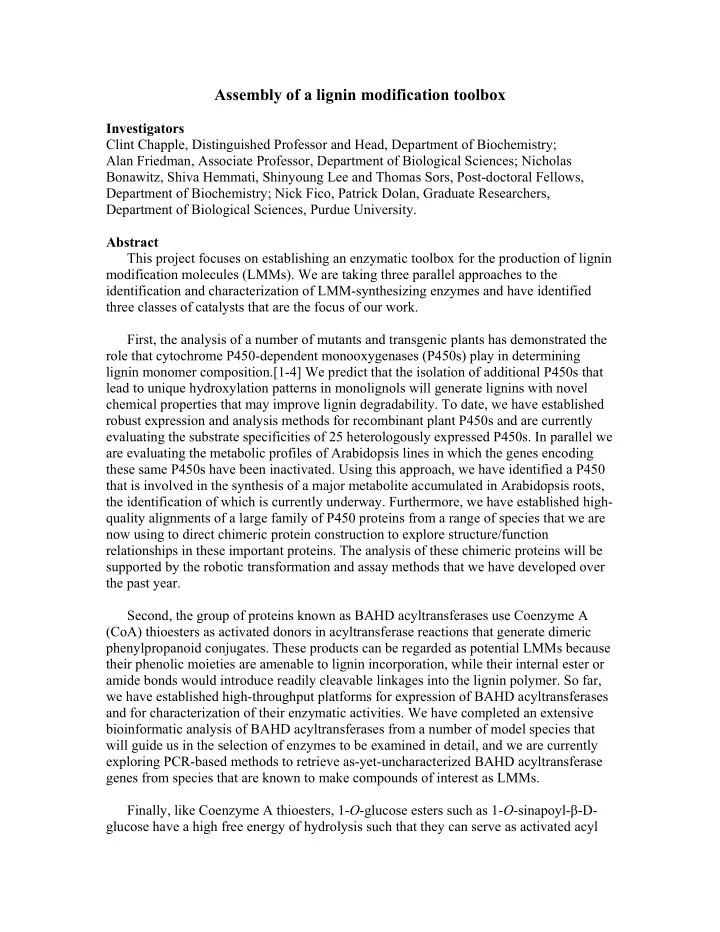

Assembly of a lignin modification toolbox Investigators Clint Chapple, Distinguished Professor and Head, Department of Biochemistry; Alan Friedman, Associate Professor, Department of Biological Sciences; Nicholas Bonawitz, Shiva Hemmati, Shinyoung Lee and Thomas Sors, Post-doctoral Fellows, Department of Biochemistry; Nick Fico, Patrick Dolan, Graduate Researchers, Department of Biological Sciences, Purdue University. Abstract This project focuses on establishing an enzymatic toolbox for the production of lignin modification molecules (LMMs). We are taking three parallel approaches to the identification and characterization of LMM-synthesizing enzymes and have identified three classes of catalysts that are the focus of our work. First, the analysis of a number of mutants and transgenic plants has demonstrated the role that cytochrome P450-dependent monooxygenases (P450s) play in determining lignin monomer composition.[1-4] We predict that the isolation of additional P450s that lead to unique hydroxylation patterns in monolignols will generate lignins with novel chemical properties that may improve lignin degradability. To date, we have established robust expression and analysis methods for recombinant plant P450s and are currently evaluating the substrate specificities of 25 heterologously expressed P450s. In parallel we are evaluating the metabolic profiles of Arabidopsis lines in which the genes encoding these same P450s have been inactivated. Using this approach, we have identified a P450 that is involved in the synthesis of a major metabolite accumulated in Arabidopsis roots, the identification of which is currently underway. Furthermore, we have established high- quality alignments of a large family of P450 proteins from a range of species that we are now using to direct chimeric protein construction to explore structure/function relationships in these important proteins. The analysis of these chimeric proteins will be supported by the robotic transformation and assay methods that we have developed over the past year. Second, the group of proteins known as BAHD acyltransferases use Coenzyme A (CoA) thioesters as activated donors in acyltransferase reactions that generate dimeric phenylpropanoid conjugates. These products can be regarded as potential LMMs because their phenolic moieties are amenable to lignin incorporation, while their internal ester or amide bonds would introduce readily cleavable linkages into the lignin polymer. So far, we have established high-throughput platforms for expression of BAHD acyltransferases and for characterization of their enzymatic activities. We have completed an extensive bioinformatic analysis of BAHD acyltransferases from a number of model species that will guide us in the selection of enzymes to be examined in detail, and we are currently exploring PCR-based methods to retrieve as-yet-uncharacterized BAHD acyltransferase genes from species that are known to make compounds of interest as LMMs. Finally, like Coenzyme A thioesters, 1- O -glucose esters such as 1- O -sinapoyl- β -D- glucose have a high free energy of hydrolysis such that they can serve as activated acyl
donors. We have identified a family of serine carboxypeptidase-like (SCPL) proteins that are in fact acyltransferases that use sinapoylglucose for the synthesis of sinapic acid esters including the LMM candidate 1,2-disinapoylglucose. We predict that expression of SCPL acyltransferases in lignifying tissues will generate LMMs with internal ester linkages that will be incorporated into the lignin polymer and vastly improve the ease with which lignin can be degraded. Our progress on this objective includes the demonstration that a novel SCPL protein from Arabidopsis is required for sinapoylation and benzoylation of glucosinolates in seeds. Further, we have found that over-expression of an SCPL protein that synthesizes a candidate LMM in Arabidopsis leads to significant perturbations in soluble and wall-bound phenylpropanoid content. Introduction Although the phenylpropanoid pathway produces many compounds of value to humans, a major goal of research on the pathway has been to improve our understanding of lignin biosynthesis.[5] Biofuel production has provided a new motivation for this interest because the quantity and quality of lignin in biomass crops interferes with the access of hydrolytic enzymes to the polysaccharide components of the plant cell wall, thereby inhibiting their conversion to fermentable monosaccharides. For this reason, the ability to manipulate lignification in biofuels crops would lead to substantial economic and environmental gains. The objective of this project is to learn how to fundamentally alter the chemistry of the lignin polymer in such a way that it radically alters the ease with which it can be removed from biofuel crops, thus substantially increasing yields of cell wall-derived sugars and the efficiency of their subsequent fermentation without compromising the viability of the plants themselves. Our approach to the assembly of our LMM enzymatic toolkit is based upon several attributes that these enzymes have in common. First, as a result of their involvement in many secondary metabolic pathways, P450s as well BAHD and SCPL acyltransferases can be found in a wide range of plants, and exhibit broad catalytic diversity. Second, although some of these enzymes have been purified and characterized through conventional biochemical approaches, a common feature of all three protein families is that the genes that encode them can be identified by their sequence alone. Furthermore, in many cases, important inferences with regard to the function of unknown proteins can be drawn from previous phylogenetic analyses, thus allowing us to retrieve candidate genes for LMM-synthesizing enzymes from genomic and EST databases. Third, we have developed methods for the heterologous expression of these unknown proteins and robust assays with which they can be challenged with a spectrum of metabolites in a high throughput manner such that their substrate specificity, and suitability for LMM synthesis, can be determined. Finally, many proteins within each class of catalyst share enough sequence homology that we can apply our newly-developed strategies for the generation of chimeric proteins so that the proteins we identify can be further refined for the production of optimal LMMs. When these native or engineered genes are over-expressed in biofuel crops, we expect that the phenolic nature of the LMMs will lead to their incorporation into the growing lignin polymer but will not compromise the function of this important cell wall
Recommend
More recommend